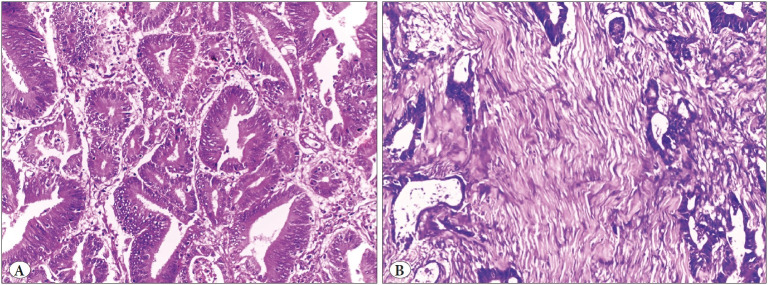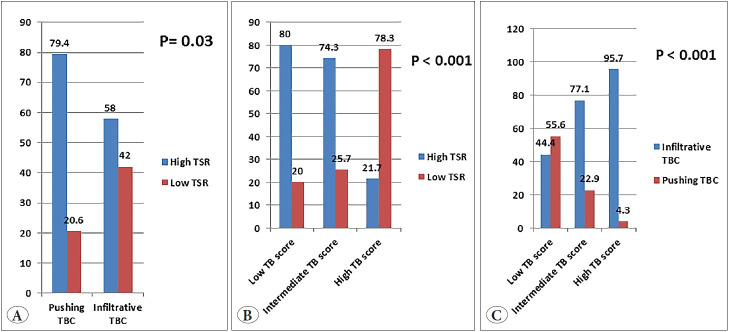The Prognostic Impact of Tumor Border Configuration, Tumor Budding and Tumor Stroma Ratio in Colorectal Carcinoma.
IF 2.1
Q4 PATHOLOGY
引用次数: 3
Abstract
Objective: Tumor border configuration, tumor budding and tumor stroma ratio are reliable histopathological parameters that play a central role in the invasion-metastasis cascade. This study aimed to investigate the prognostic impact of these parameters and a new combined score in colorectal cancer. Material and Method: A cohort of 103 colorectal cancer surgical specimens was retrospectively evaluated for tumor border configuration, tumor budding and tumor stroma ratio using H&E sections. A combined risk score was then constructed to divide cases into low risk-tumors and high risk-tumors. Results: Infiltrating tumor border, high tumor budding, low tumor stroma ratio and high combined risk score were associated with positive lymph node involvement, presence of metastasis, high tumor grade, lymphovascular invasion, poor overall survival and short recurrence-free survival. Infiltrating tumor border, high tumor budding and high combined risk score were associated with advanced T stage. High tumor budding, and low tumor stroma ratio were associated with perineural invasion. Infiltrating tumor border was associated with increased tumor size and conventional adenocarcinoma, high tumor budding and low tumor stroma ratio. Low tumor stroma ratio was associated with high tumor budding. On multivariate survival analysis, tumor stroma ratio was found to be an independent predictor for overall survival and recurrence-free survival. Conclusion: Tumor border configuration, tumor budding, tumor stroma ratio and the newly constructed combined risk score are potential predictors of outcome in colorectal cancer patients, suggesting that their incorporation in the routine histopathological evaluation could be useful in determining the prognosis of colorectal cancer cases.



结直肠癌中肿瘤边界形态、肿瘤出芽和肿瘤间充质比率对预后的影响。
目的:肿瘤边界形态、肿瘤出芽和肿瘤间质比例是可靠的组织病理学参数,在侵袭转移级联中起着核心作用。本研究旨在研究这些参数和一种新的结直肠癌综合评分对预后的影响。材料和方法:采用H&E切片对103例癌症大肠癌手术标本的肿瘤边界形态、肿瘤出芽和肿瘤间质比例进行回顾性评价。结果:浸润性肿瘤边界、高肿瘤出芽、低肿瘤间质比例和高综合风险评分与淋巴结转移阳性、肿瘤分级高、淋巴管浸润、总生存率低和无复发生存期短有关。浸润性肿瘤边界、高肿瘤出芽和高综合风险评分与晚期T分期相关。高肿瘤出芽率和低肿瘤间质比率与神经侵袭有关。浸润性肿瘤边界与肿瘤大小和常规腺癌增加、肿瘤出芽率高和肿瘤间质比例低有关。肿瘤间质比例低与肿瘤出芽率高有关。在多变量生存分析中,肿瘤间质比率被发现是总生存率和无复发生存率的独立预测因素。结论:肿瘤边界形态、肿瘤出芽、肿瘤间质比率和新构建的联合风险评分是结直肠癌癌症患者预后的潜在预测因素,表明将其纳入常规组织病理学评估可用于确定结直肠癌癌症患者的预后。
本文章由计算机程序翻译,如有差异,请以英文原文为准。
求助全文
约1分钟内获得全文
求助全文

 求助内容:
求助内容: 应助结果提醒方式:
应助结果提醒方式:


